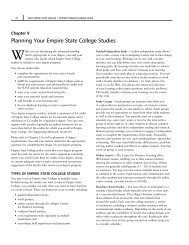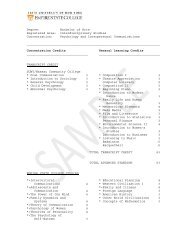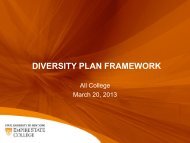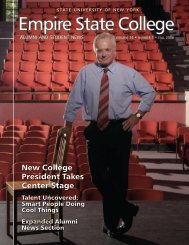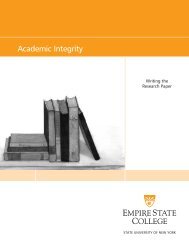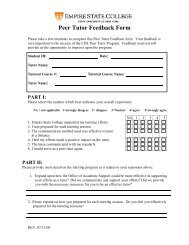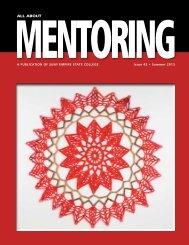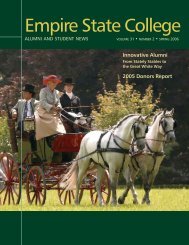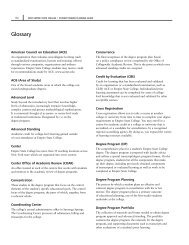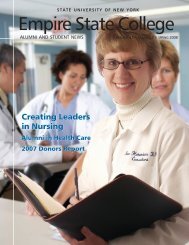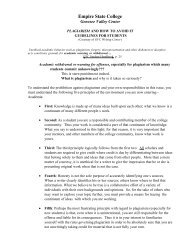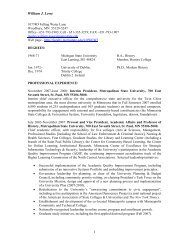Academic Plan 2011-2015 (PDF 524kB) - SUNY Empire State College
Academic Plan 2011-2015 (PDF 524kB) - SUNY Empire State College
Academic Plan 2011-2015 (PDF 524kB) - SUNY Empire State College
Create successful ePaper yourself
Turn your PDF publications into a flip-book with our unique Google optimized e-Paper software.
26 <strong>SUNY</strong> <strong>Empire</strong> <strong>State</strong> <strong>College</strong>: <strong>Academic</strong> <strong>Plan</strong> <strong>2011</strong> - <strong>2015</strong>To date, directors of academic support, who are professionally responsible for assessing the skills andmeeting the developmental needs of undergraduate students, have been hired at the seven regionalcenters, The Harry Van Arsdale Jr. Center for Labor Studies and the Center for Distance Learning. Someof these directors also serve graduate students if the situation arises and resources permit it, but othersdo not. This situation violates desired codes of consistency across the college.One initial and necessary task is, thus, to survey the needs of the graduate students. Evidence,(including a report issued by the graduate faculty), suggests that there are gaps between the skills ofsome incoming graduate students and the requirements of their programs. We must determine howto deploy services to meet these needs. For instance, one way of serving graduate students might beto widen the purview of the current directors, while providing more resources and learning coaches tocontinue to meet the needs of undergraduate students. Another option might be to hire a collegewidedirector of graduate academic support and provide substantial “cloud” resources to that person tomeet the needs of graduate students.Objective B2.3: Make orientation make a differenceThe college’s virtue –meeting the needs of students who are not well served by other institutions –also creates a responsibility to introduce new students meaningfully to this highly unusual educationalenvironment. We cannot expect students to understand this place when they arrive here, as theirunderstanding and expectations will be predicated on experiences at other types of schools and/orhearsay – or, with luck, by attendance at an information session.Orientation, which is an important function at every college, is even more important for studentsnew to <strong>Empire</strong> <strong>State</strong> <strong>College</strong>. For this reason, a number of groups – including the student servicesprofessionals and the directors of academic support, as well as faculty – have been studying how toconvert orientation from a single event into an ongoing process. Our goal is to find ways to scaffoldthe information delivery in order to prepare students step-by-step to become fully functioningindependent learners.During 2010 - <strong>2011</strong>, the student services professionals (SSPs) have compiled and analyzed data fromorientations across the college at the undergraduate level. This project recently culminated in a reportthat has been submitted to the deans for consideration. As they become available, recommendationsstemming from this project should be incorporated into this academic plan and its iterations.In addition to the SSPs’ plans for orientation, and dovetailing neatly with the college’s plan to createa culture of assessment, students from the point of first contact may be encouraged and supported aspart of an extended orientation process to assess and periodically reassess their own academic skillsthrough the work of the directors of academic support. As discussed elsewhere, this will help themto determine their specific strengths and challenges before beginning their studies and then as theycontinue, thus enhancing their academic self-development during their time at the college.




